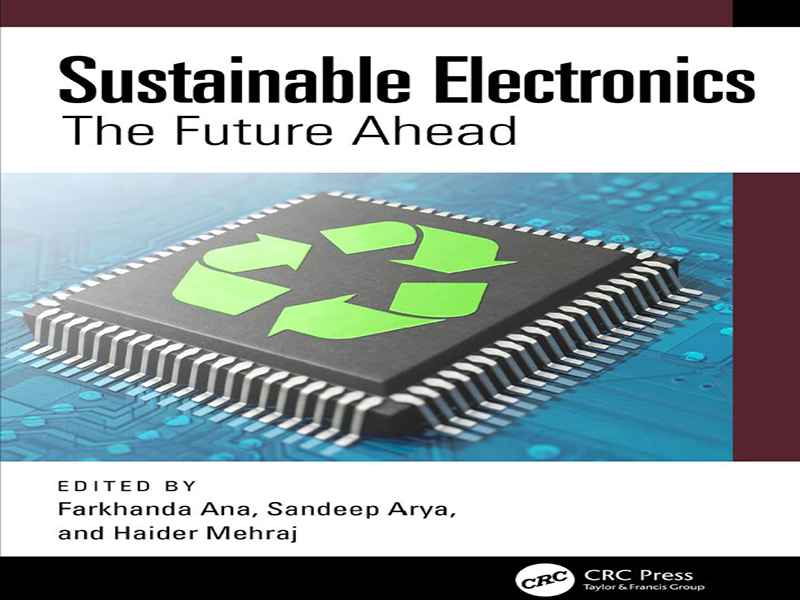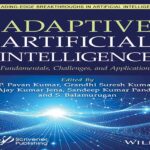- عنوان کتاب: Sustainable Electronics -The Future Ahead
- نویسنده: Farkhanda Ana
- حوزه: الکترونیک پایدار
- سال انتشار: 2025
- تعداد صفحه: 376
- زبان اصلی: انگلیسی
- نوع فایل: pdf
- حجم فایل: 11.8 مگابایت
پایداری در الکترونیک زمانی مطرح میشود که دستگاهها با در نظر گرفتن تأثیر بر مردم و سیاره طراحی شوند. طراحی پایدار به دلیل اثرات برگشتناپذیر زبالههای الکترونیکی بر محیط زیست، حیاتی شده است. پردازش مواد نیمههادی، انتشار گازهای سمی و تجزیهناپذیری مواد خطرناک به ویژه اکسیدهای فلزی، تأثیر نامطلوبی بر سیاره زمین دارد. برای تحقق رویای یک سیاره سبز، باید سیاستهای سازگار با محیط زیست و روشهای طراحی و موادی را تدوین کنیم که نه تنها الزامات عملکرد را برآورده کنند، بلکه منجر به یک جامعه کم کربن نیز شوند. در طول دو دهه گذشته، تقاضا برای شیوههای طراحی پایدار افزایش یافته است تا به جامعه کمک کند تا مدت بیشتری زنده بماند. برای دستیابی به هدف پایداری در بازار الکترونیک، حوزه مواد نقش کلیدی ایفا میکند. موادی که زیست تخریبپذیر و زیست سازگار هستند را میتوان با طراحی دستگاه الکترونیکی ادغام کرد تا منجر به یک دنیای الکترونیک پایدار شود. فرآیندهای تولید و ساخت پایدار که انتشار و تولید گازهای سمی را کاهش میدهند، دومین عامل مهم در جهت یک دنیای الکترونیک پایدار است. اتخاذ شیوههای پایدار و تدوین سیاستها، سومین عامل مهم در جهت پایداری در الکترونیک است. هدف این کتاب، ارائه گزارشها و تحقیقات علمی ارزشمند در مورد پایداری در حوزه الکترونیک است. این کتاب با انتخاب دقیق موضوعات و بررسیهای دقیق، طیف کاملی از پایداری در الکترونیک را پوشش میدهد. این کتاب به موضوعات متنوعی از اصول اولیه، مواد پایدار، الکترونیک پوشیدنی، کاربردهای سلول خورشیدی، نانوذرات، اینترنت اشیا، سیاستهای مدیریت پسماندهای الکترونیکی، اقتصاد چرخشی و آینده و روندهای نوآورانه تا پایداری میپردازد. اگرچه انتخاب و استفاده از مواد الکترونیکی برای کاربردهای طراحی پرسرعت یک مسئله حیاتی است، اما تأثیر آن بر محیط زیست با استفاده از اجزای فلزی و زیستتخریبپذیر بسیار زیاد است. در نتیجه، تعداد دستگاههای منسوخ شده به ازای هر کاربر در سال افزایش مییابد که منجر به افزایش زبالههای الکترونیکی میشود. سازمان ملل متحد در سال 2021 گزارش داده است که هر فرد روی کره زمین به طور متوسط 7.6 کیلوگرم زباله الکترونیکی تولید میکند که تقریباً 57.4 میلیون تن زباله الکترونیکی در سراسر جهان تولید میکند. تنها 17.4٪ از این زبالههای الکترونیکی حاوی ترکیبی از مواد مضر و مواد گرانبها به درستی جمعآوری، تصفیه و بازیافت میشوند. طبق گزارش «پایش جهانی زبالههای الکترونیکی ۲۰۲۰»، جهان در سال ۲۰۱۹، ۵۳.۶ میلیون تن زباله الکترونیکی تولید کرده است که تنها ۹.۳ میلیون تن (۱۷٪) از آن جمعآوری و بازیافت شده است. برای کاهش زبالههای الکترونیکی و تأثیر مضر آن بر کره زمین، تلاش برای یافتن مواد الکترونیکی زیستتخریبپذیر و زیستسازگار توجه بسیاری از محققان را به خود جلب کرده است. مهندسی علوم مواد منجر به سنتز و شناسایی مواد رسانا/عایق از مواد طبیعی یا مشتقات آنها شده است. این مواد هنگامی که با الکترونیک ادغام میشوند، منجر به کاربردهای الکترونیکی زیستتخریبپذیر و پایدار میشوند که اثرات خطرناک بر محیط زیست را کاهش میدهند. سیاستهای پایدار و اقتصاد چرخشی به تفصیل در این کتاب مورد بحث قرار گرفته است. این کتاب به عنوان یک مرجع و منبع اطلاعاتی برای محققان در زمینه علوم مواد، مهندسی الکترونیک و برق و همچنین فیزیکدانان و مهندسان طراحی عمل خواهد کرد. این کتاب شامل فصلهای زیر است: فصل ۱: این فصل اصول کلیدی پایداری، نگرانیهای زیستمحیطی و مقررات دولتی اتخاذ شده برای دستیابی به آیندهای پایدار را مورد بحث قرار میدهد. علاوه بر این، تحقیق و توسعه مواد سازگار با محیط زیست، زیست تخریب پذیر یا قابل استفاده مجدد مانند بیوپلاستیکها، گرافن، نانومواد و مواد آلی نیز مورد بحث قرار گرفته است. فصل 2: تحقیقات متعدد در مورد استفاده از نانوکامپوزیتهای فریت اسپینل (SFNCs) و نانوذرات فریت اسپینل (SFNPs) در طول فرآیند تصفیه آب و آبهای آلوده، نقش خطرناک آنها را در تضمین دسترسی به آب شیرین برای مصرف انسان و رفاه آبزیان در مقیاس جهانی نشان داده است. این فصل آخرین پیشرفتها و کاربردهای احتمالی SFNها را برای جذب یونهای فلزات آلی و سنگین و همچنین میکروبهای باکتریایی و قارچی و سایر ناخالصیهای آبی توضیح میدهد. خواص مغناطیسی عالی، سطح فعال صریح عالی، شکل و اندازههای قابل تنظیم با پایداری بسیار بالا، از مهمترین ویژگیهای فیزیکوشیمیایی SFNها هستند. فصل 3: این فصل به بررسی خواص و کاربردهای مواد نانوسلولز به عنوان یک ماده الکترونیکی میپردازد. نانوسلولز زیست تخریب پذیر در نظر گرفته میشود و ضایعات الکترونیکی را کاهش میدهد. این فصل به تفصیل چالشها، کاربردها، روشهای تولید و مزایای بالقوه نانوسلولز را مورد بحث قرار میدهد. فصل ۴: سیستمهای دیالکتریک پایدار بیشترین توجه را در بین جامعه تحقیقاتی در … به خود جلب کردهاند.
Sustainability in electronics arises when the devices are designed keeping in view the impact on the people and planet. Sustainable design has become critical because of the irreversible effects of electronic waste on the environment. The processing of semiconductor materials, release of toxic gases, and non‑biodegradability of hazardous materials particularly metallic oxides have an adverse effect on the planet. To fulfill the dream of a green planet, we need to devise eco‑friendly policies and design methods and materials meeting not only the performance requirements but also resulting in a low‑carbon society. During the past two decades, the demand for sustainable design practices has increased to help the society survive longer. To accomplish the goal of sustainability in the electronics market, the materials domain plays a key role. Materials that are biodegradable and biocompatible can be integrated with the electronic device design to result in a sustainable world of electronics. Sustainable manufacturing and fabrication processes reducing the release and production of toxic emissions is the second important factor toward a sustainable electronic world. Adopting sustainable practices and devising policies becomes the third and equally important factor toward sustainability in electronics. The aim of this book is to bring in valuable scientific reports and research on sustainability in the field of electronics. Through careful selection of the topics and rigorous reviews, this book covers the entire spectrum of sustainability in electronics. This book caters to diverse topics from the fundamentals, sustainable materials, wearable electronics, solar cell applications, nanoparticles, internet of things, electronic waste management policies, circular economy and the future, and innovative trends to sustainability. Though the selection and use of electronic materials for high‑speed design applications is a critical issue, its impact on the environment with the use of metallic and non‑biodegradable components is immense. As a result, the number of obsolete devices per user increases per year resulting in an increase in electronic waste. It has been reported by the United Nations in 2021 that each person on the planet would produce on average 7.6 kg of e‑waste generating approximately 57.4 million tons of e‑waste worldwide. Only 17.4% of this electronic waste containing a mixture of harmful substances and precious materials is being properly collected, treated, and recycled. According to the Global E‑waste Monitor 2020, the world gener‑ated 53.6 Mt of e‑waste in 2019, only 9.3 Mt (17%) of which was recorded as being collected and recycled. To reduce electronic waste and its detri‑mental impact on the planet, the quest for biodegradable and biocompatible electronic materials has caught the attention of many researchers. Materials science engineering has resulted in the synthesis and identification of con‑ductive/insulating materials from natural substances or their derivatives. These materials when integrated with electronics result in biodegradable and sustainable electronic applications reducing the hazardous effect on the environment. The sustainable policies and circular economy has been discussed in detail in this book. This book will serve as a reference and informative literature for researchers in the field of materials science, elec‑tronic and electrical engineering as well as physicists and design engineers.This book comprises the following chapters: Chapter 1: This chapter discusses the key principles of sustainability, environmental concerns, and government regulations adopted to achieve a sustainable future. Furthermore, research and development of eco‑friendly, biodegradable, or reusable materials such as bioplastics, graphene, nano‑materials, and organic materials is also discussed. Chapter 2: Numerous investigations on the usage of spinel ferrite nano‑composites (SFNCs) and spinel ferrite nanoparticles (SFNPs) throughout the treatment process of water and tainted water have revealed their peril‑ous part in ensuring fresh water obtainability for human consumption and the well‑being of aquatic life on a global scale. This chapter elucidates the latest developments and possible uses of SFNs for absorbing organic and heavy metal ions as well as bacterial and fungal microbes and other aquatic impurities. Excellent magnetic properties, great explicit active surface area, tunable shape, and sizes with giant stability are the foremost physiochemi‑cal characteristics of SFNs. Chapter 3: This chapter discusses the material properties and applica‑tions of nanocellulose as an electronic material. Nanocellulose is considered biodegradable, reducing electronic waste. This chapter discusses in detail the challenges, applications, manufacturing methods, and potential advan‑tages of nanocellulose. Chapter 4: Sustainable dielectric systems have become the greatest atten‑tion among the research community in the age of modern technology and scientific research evolution, not only due to their exciting utilization in several solid‑state devices, such as optoelectronics devices, IR transmission, fiber optics, memory sensors, holography, and laser technology, but also due to academic engrossment in thermo‑electrical and structural trans‑port properties. Fe‑doped ‑CdO‑ZnO glassy dielectric systems have been developed and their electrical and dielectric properties have been explored extensively in terms of hopping of small polarons. The microstructure of the as‑developed system has been revealed in terms of identifying various nanophases such as ZnO, CdO, Cd9.5 Zn0.5, ZnV, Zn3V2O8. Chapter 5: This chapter covers a wide spectrum of solar cells, including photovoltaic (PV) cells, organic PV cells, thin‑film PV cells, and the most recent advances in solar cell technology. The chapter also examines the materials, manufacturing procedures, and life cycle evaluations necessary for the ecologically sustainable progress of solar cell technology. In this chapter, the challenges in implementing sustainable solar cells, laying the groundwork for a discussion of current studies, financial factors, and policy ramifications have also been discussed. Chapter 6: This chapter proposes and investigates regular Perovskite Solar Cell (PSC) design. Initially, regular homojunction PSC with layered structure has been designed and investigated. The proposed architectural framework identifies different physical parameters of the perovskite mate‑rial as key contenders influencing the design of PSC. In this chapter, the cru‑cial parameters of the proposed PSC are systematically evaluated, analyzed, discussed, and subsequently calibrated to achieve optimized outcomes, yielding a PCE of 26.8%, Voc of 1.2 V, FF of 87.9%, and Jsc of 26.6 mA/cm2. Chapter 7: Numerous advancements have been made in this area of wear‑able textiles for improving the life quality of people, especially those with dementia or moderate cognitive impairment. This chapter also discusses the concept and challenges associated with electronic textiles development for meeting specific functions like behavior assessment for people with Alzheimer’s disease and moisture assessment on the skin. Further to this, architecture is discussed in detail in order to design the product with flex‑ibility for a better living environment. Chapter 8: MXenes, a group of 2D transition metal carbides and nitrides, exhibit remarkable mechanical flexibility, electrical conductivity, and ease of production, making them highly attractive for use in flexible electron‑ics. This chapter provides a more in‑depth analysis of the production pro‑cedures, mechanical and electrical properties, and many uses of MXenes in the field of flexible electronics. Due to their remarkable characteristics, MXenes have garnered significant interest for incorporation into flexible electronics, hence creating novel prospects in several sectors. Chapter 9: In this chapter, the semiconducting properties of graphene and its applications have been discussed in detail. The wide variety of appli‑cations of graphene as biosensors, energy storage devices, batteries, super capacitors, and solar cells have been reviewed to catch the reader’s interest in this chapter. Chapter 10: This chapter discusses the sustainability principles in Internet of Things (IoT). The key aspects of Green IoT, smart cities, smart grids, and waste management have been broadly discussed in this chapter. Chapter 11: In this chapter, the integration of Artificial Intelligence/Machine Learning with wearable Electronic devices/body sensors/wearable sensors has been discussed. This chapter focuses on the practical application and investigates the role of Machine Learning in the wearable Electronics field. The integration of Artificial Intelligence/Machine Learning in wear‑able devices can make these devices learn and adapt to the user’s habits, which will make this technology seamlessly integrate into our daily lives. Chapter 12: This chapter deals with the fabrication processes of elec‑tronic components with a particular emphasis on environmentally friendly methodologies. It investigates novel materials and manufacturing tech‑niques that minimize ecological impact while maintaining performance standards. The book chapter not only focuses on the green aspects of fab‑rication but also extends its scope to the application of these eco‑friendly electronic components. It examines the integration of green technologies in various electronic devices, highlighting real‑world scenarios where sustain‑able practices can be implemented without compromising functionality. Chapter 13: In this chapter, the problem of electronic waste has been addressed. This chapter discusses some venues of sustainability for elec‑tronics for making electronic products durable, ideal, and for technolog‑ical solutions. It also examines ways that can foster a circular economy for electronics from businesses’ operations, policies, and users’ behaviors. This chapter explores sustainable manufacturing processes for electronics, including energy‑efficient production techniques, waste reduction strate‑gies, and green supply chain management. Chapter 14: Materials science advances are leading to environ‑ment‑focused components, as newer design techniques increase product life and recyclability. The future of sustainable electronics is massive due to energy breakthroughs for greater efficiency and flexible electronic inte‑grations. This chapter explores these developments and looks at how they might turn the electronics industry into a greener and more responsible one. A number of innovative trends like biomimicry, energy harvesting, and wireless charging have been elaborated in this chapter.
این کتاب را میتوانید از لینک زیر بصورت رایگان دانلود کنید:
Download: Sustainable Electronics



































نظرات کاربران